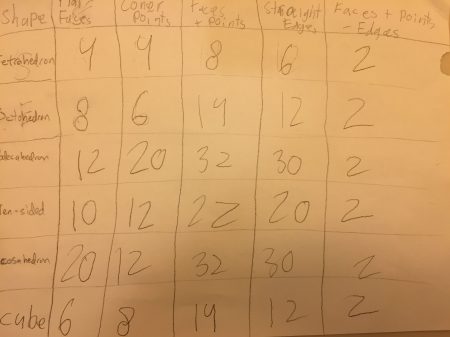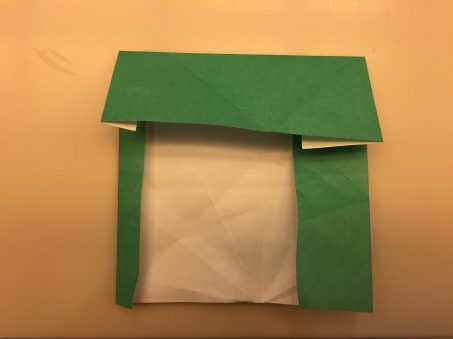The Activities
- Topics: Geometry, Three Dimensional Shapes: Book: Sir Cumference and the Sword in the Cone by C. Neuschwander.
- Topics: Geometry, Three Dimensional Shapes: A while ago we bought 5 full sets of “D&D dice” (4, 6, 8, 10, 12, and 20 sided). We counted the edges, faces, and vertices for each of these and made a chart like in Sir Cumference, showing that “Faces + Vertices – Edges = 2”. I also pointed out the dual relationship between 6 & 8 and 12 & 20 sided polyhedra (i.e., 6-sided has 6 faces, 8 vertices, and 12 edges; 8-sided has 8 faces, 6 vertices, and 12 edges; you can switch between the two by putting a vertex in the middle of each face and connecting adjacent vertices).

- Topic: Numbers: We did What’s the Secret Code? from youcubed.org. There are some clues about what the secret number is like “The digit in the hundreds place is ¾ the digit in the thousands place.” There is more than one answer which is cool.
- Topics: Origami, Geometry: We did Paper Folding from youcubed.org. There are a number of folding challenges like “Construct a square with exactly ¼ the area of the original square. Convince yourself that it is a square and has ¼ of the area.”

How Did It Go?
We had four kids this week. As usual some kids followed along better than others, but most people were engaged for both the dice activity and the paper folding.
Sir Cumference and the Sword in the Cone
The kids liked the book, they laughed at quite a few of the math puns.
Euler’s Polyhedron Formula
The kids definitely enjoyed making the chart. They did a pretty good job staying on task (it was easy to get distracted and start rolling the dice). Counting the edges on some of the dice was fairly tricky but was much easier with good grouping strategies.
What’s the Secret Code?
The kids did well on this except that they had trouble with the decimals. They did find one of the decimal answers, because they knew that .5 = 1/2, but I believe there were other possible decimal answers as well.
Paper Folding
The kids solved all the tasks except the last one, which was making a non-diagonal 1/2 area square. I figured out a pretty complicated way to do it (by transferring the side length of the diagonal answer onto a horizontal edge), they copied what I did but it was pretty tricky (see picture above).

